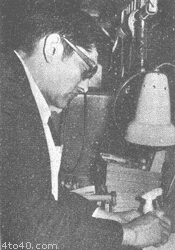 Devendra Lal — At 6.00 p.m. G.M.T. on November 22, 1973, an American astronaut, Edward Gibson, came out of Skylab-3 carrying a small packet. Crawling on the hull of the spacecraft on his life line he reached a pre-determined spot on the spacecraft and clamped the packet to it. More than two months later, on February 3, 1974, at the same hour, he came out again to retrieve the packet. This was not a space exercise but a vital scientific experiment which Devendra Lal and his colleague, S. Biswas, had proposed to the US National Aeronautical and Space Administration. The packet was a cosmic ray detector. To measure the intensity of cosmic rays in space was the purpose of the experiment.
Devendra Lal — At 6.00 p.m. G.M.T. on November 22, 1973, an American astronaut, Edward Gibson, came out of Skylab-3 carrying a small packet. Crawling on the hull of the spacecraft on his life line he reached a pre-determined spot on the spacecraft and clamped the packet to it. More than two months later, on February 3, 1974, at the same hour, he came out again to retrieve the packet. This was not a space exercise but a vital scientific experiment which Devendra Lal and his colleague, S. Biswas, had proposed to the US National Aeronautical and Space Administration. The packet was a cosmic ray detector. To measure the intensity of cosmic rays in space was the purpose of the experiment.
When cosmic rays which come from space strike the surface of the earth, the ocean bed, the moon or a meteorite, they produce some nuclear changes and leave fine tracks in the rocks they traverse. Using a variety of techniques these “signatures” can be detected. As cosmic rays were present when the solar system was forming, their “signatures”, millions of years old, in the rocks could be used to shed light on that period.
Lal made extensive studies of meteorites, of lunar rocks brought by the Apollo and Luna Missions and of material from the ocean bed. He also evolved techniques to understand past events in the solar system from cosmic ray “signatures.” One of his most significant findings is that the intensity of cosmic rays during the last few million year has been the same as it is today.
Lal, one of the world’s leading geophysicists, is associated with the Physical Research Laboratory, Ahmedabad. He is also visiting Professor of the Scripps Institution of Oceanography in California, USA.
Lal was born on February 14, 1929, in Varanasi. During his schools and college days he used to earn pocket money by selling cosmetics and varieties of ink he made at home. He joined the Tata Institute of Fundamental Research when he was only 20. Under the guidance of Prof. Bernard Peters, an eminent physicist, Lal learned the mysteries of research. No wonder he once remarked that “a good scientist should choose a good professor and learn from him the basic methods of science. Sitting at his feet is not sufficient, probably not even necessary”.
For his significant contributions he was awarded the S. S. Bhatnagar Award in 1967 and the Krishnan Medal in 1965. He is also Foreign Associate of the US National Academy of Sciences, a rare honour for any scientist.
 Kids Portal For Parents India Kids Network
Kids Portal For Parents India Kids Network






